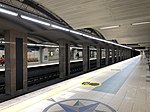Santa Justa Lift

The Santa Justa Lift (Portuguese: Elevador de Santa Justa, pronounced [elɨvɐˈdoɾ dɨ ˈsɐ̃tɐ ˈʒuʃtɐ]), also called Carmo Lift (Portuguese: Elevador do Carmo, [elɨvɐˈdoɾ du ˈkaɾmu]), is an elevator, or lift, in the civil parish of Santa Justa, in the historic center of Lisbon, Portugal. Situated at the end of Rua de Santa Justa, it connects the lower streets of the Baixa with the higher Largo do Carmo (Carmo Square). Since its construction the lift has become a tourist attraction for Lisbon as, among the urban lifts in the city, Santa Justa is the only remaining vertical (conventional) one. Others, including Elevador da Glória and Elevador da Bica, are actually funicular railways, and the other lift constructed around the same time, the Elevator of São Julião, has since been demolished.
Excerpt from the Wikipedia article Santa Justa Lift (License: CC BY-SA 3.0, Authors, Images).Santa Justa Lift
Rua Áurea, Lisbon Baixa (Santa Maria Maior)
Geographical coordinates (GPS) Address Website Nearby Places Show on map
Geographical coordinates (GPS)
| Latitude | Longitude |
|---|---|
| N 38.712222222222 ° | E -9.1394444444444 ° |
Address
The Lift Boutique Hotel
Rua Áurea 265
1100-062 Lisbon, Baixa (Santa Maria Maior)
Portugal
Open on Google Maps








